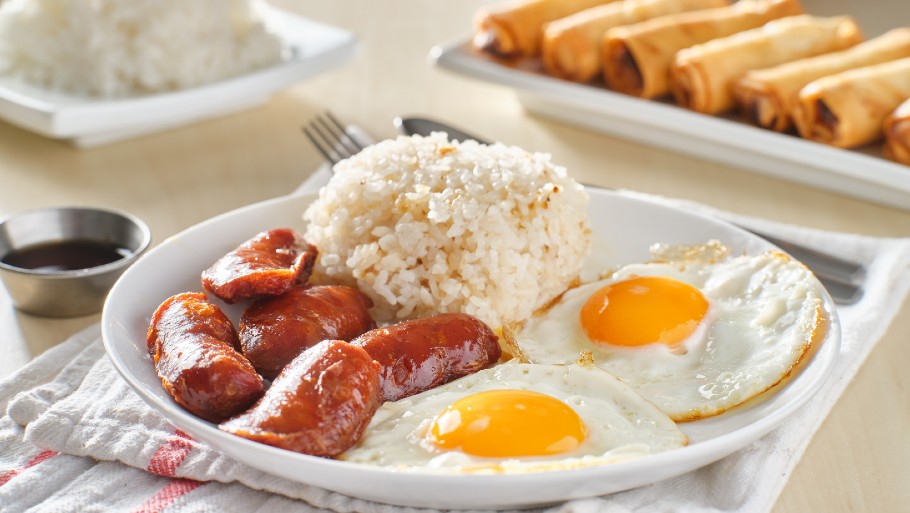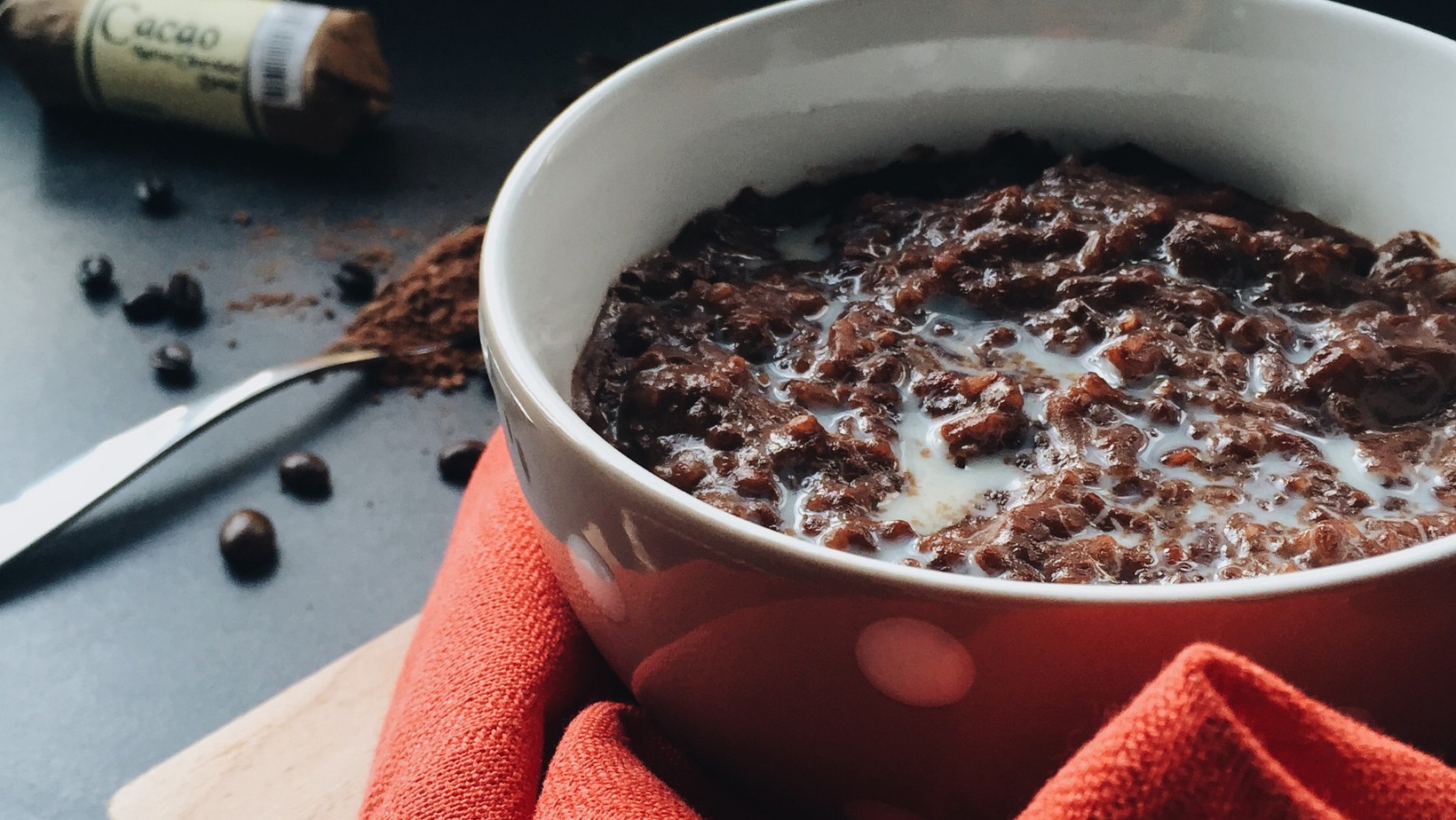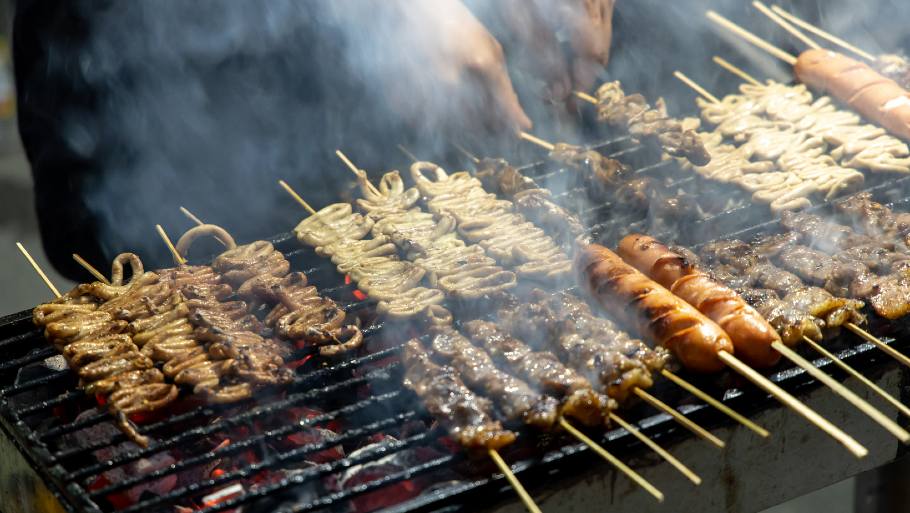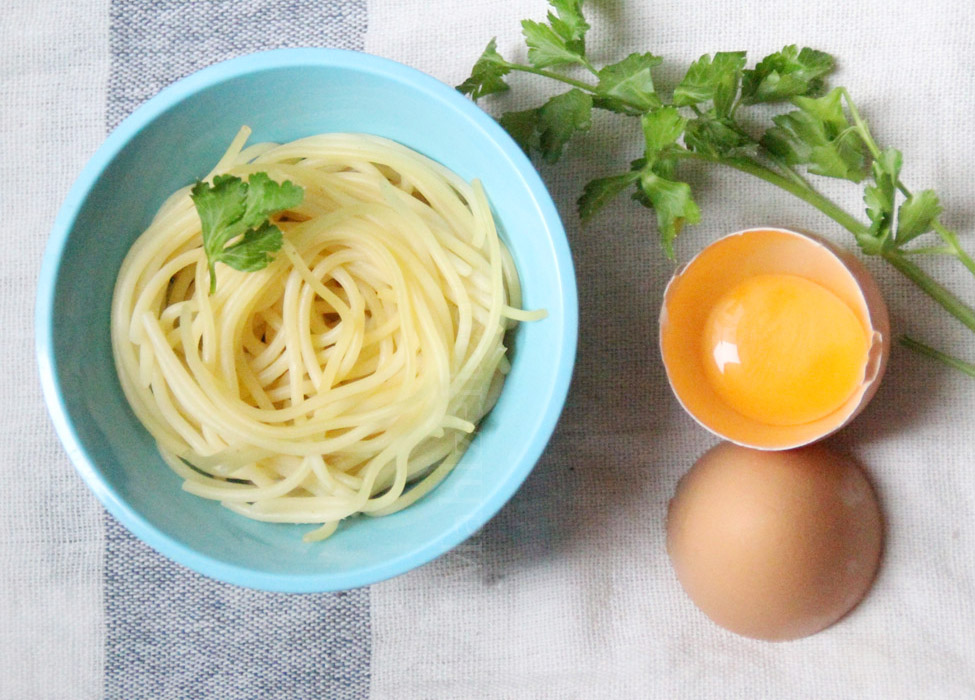
A recent article about travel and food has been circling the blogosphere for what seem to be a negative take on Filipino (street) food. I will not condemn nor agree with the blog owners, rather, I would like to suggest certain places where one could enjoy a good meal (not necessarily on the streets) but are very affordable. Let’s say with a 25$ per head (roughly 1,121 pesos or 19.50€ ) budget a day – spanned across 3 meals and some snacks in between.
It can’t be guaranteed that street food in the Philippines are prepared in pristine conditions nor are they germ-free as most around the world, a topic of growing public health concern.
Not giving importance to preparation, here are some of the food one can have on a budget while in the Philippines. This is our favorites, so feel free to comment yours or ask away. Most food places offer various menus on this list, so you might see the same places often.

Breakfast
Taho
This is categorized as a snack but is best eaten in the morning, when the vendors would bring them fresh and warm, swinging two metal containers and balancing them on their shoulders while shouting around the neighborhood in a very distinct call to loyal customers: “tahooooooooooo!!!” You’d be sure to see young and old alike queuing with a a glass on one hand and money on the other. Others would go as far as taking a pitcher to buy more.
This soft/silken tofu with arnibal (sweetener and flavoring, sometimes melted brown sugar), and sago pearl (tapioca) can also be bought in plastic cups provided by vendors. Yes, best eaten in the morning because it’s power-packed with protein giving you the energy you need for the day.
Where to find:
From vendors early in the morning
: certain restaurant chains sell chilled taho, try the strawberry taho — probably in Baguio 🙂
: And yes, 10 pesos…for barely 0.25¢, you’re good to go.
Combination of Silogs (sinangag and itlog / Fried rice and egg)
It’s no secret that a typical Filipino dish consists of rice, regardless of the time of the day. Fried rice are staple during breakfasts, probably in a way to save cooked rice from going bad, it’s generally hot in the Philippines so frying left over rice is a practical option. Normally, it is only fried on garlic but, putting in some veggies is also a wonderful idea along with a beaten egg.
One popular fare would be a combination of silogs, portmanteau of singangag and itlog with another viand; that’s fried rice, egg cooked either sunny side up or scrambled, and a choice of local meat. The kind of meat is then added to the portmanteau. It can also be served with tomatoes and salted eggs. The list for this is quite long.

Tapsilog = tapa + sinangag + itlog
:tapa, cured meat that’s been marinated in soy sauce and calamansi…yes,it is of Spanish origin
Tocilog = tocino + sinangag + itlog
:tocino, another type of cured meat from Spain like baconr, rather sweet though
Longsilog = longganisa + sinangag + itlog
:longganisa, literally Spanish sausage, in the Philippines they are sausages flavored according to region and varies from being sweet to spicy to sour, salty and garlicky
Bangsilog = bangus + sinangag + itlog
: bangus, milkfish in Filipino, the fish is usually butterflied and deboned and marinated in soy sauce, vinegar, pepper and garlic. It is then fried to a crisp and could be dipped in vinegar.

Hotsilog = hotdogs + sinangag + itlog
: hotdogs, particularly the juicier, red hotdogs that Filipinos love…they’re the same as American hotdogs, only deeper in color
Spamsilog = spam + sinangag + itlog
: spam, yes, the mysterious meat in the can
Dangsilog = danggit + sinangag + itlog
: danggit, is the Filipino name for the rabbitfish, it is best served dried, popularly a product of the city of Cebu, served crispy and dipped in vinegar
Cornsilog = corned beef+ sinangag + itlog
: corned beef, need i say more?
The list goes on, Filipinos being very creative with combining food flavors and matching them well to tickle one’s palate. Include in this list: omelette of eggplant and ground beef, hamburger patty, porkchop, battered drumstick, dried fish, and smoked fish.

Where to find:
: Sinangag Express at 70-120Pesos/1.55-2.70$
: Max’s restaurant at 170-220Pesos/3.80-4.90$
: Goodah at 120-200Pesos (You can find Goodah branches here.)
Champorado
Champorado is a sweet chocolate rice porridge. It is typically made by cooking glutinous rice with cocoa powder and sugar, resulting in a rich and creamy texture. It’s often served as a breakfast or snack, especially during rainy or cold weather.

Tuyo
Tuyo is a Filipino term for dried fish, particularly salted dried herring or anchovies. It is a common pantry staple in Filipino households, enjoyed for its salty and savory flavor. Tuyo is often pan-fried until crispy and served as a breakfast dish, usually accompanied by garlic fried rice, sliced tomatoes, and fried eggs but is best paired with Champorado. It can also be cooked in olive oil with garlic and chili peppers, creating a flavorful topping for pasta or enjoyed with steamed vegetables. Tuyo is cherished for its simplicity and versatility, making it a favorite comfort food among Filipinos, especially those who appreciate its unique taste and aroma.
Where to find:
: Tapa King at 120Pesos/2.70$
—
Snacks
Filipinos have snacks in between breakfast and lunch, around 10:30 and in the afternoon – around 3 or so, what locally called Merienda. Some of these snacks are also served as desserts.
Turon
Turon is a popular Filipino snack or dessert made with ripe plantains (saba bananas) and jackfruit, wrapped in a spring roll wrapper, then deep-fried until crispy. It’s usually coated with caramelized sugar, giving it a sweet and crunchy exterior. Turon is commonly enjoyed as a merienda (snack) and is often sold by street vendors in the Philippines.
Banana Cue and Camote Cue
Banana Cue is a popular Filipino street food made from deep-fried bananas coated in caramelized brown sugar on skewers. It’s a sweet and crunchy snack often sold by street vendors or found in local markets and is enjoyed as a quick treat or dessert.
Camote Cue is similar to Banana Cue but made with sweet potatoes (camote) instead of bananas. The sweet potatoes are also coated in caramelized brown sugar and skewered before being deep-fried. Camote Cue offers a unique combination of sweet and savory flavors and is a beloved street food in the Philippines.

Halo-halo
Halo-halo is a famous Filipino dessert that translates to “mix-mix” in English. It’s a colorful and refreshing dessert made with a mix of ingredients such as shaved ice, sweetened fruits (like jackfruit, banana, and beans), jellies, sweetened beans, leche flan (caramel custard), ube (purple yam), and evaporated milk. It’s often topped with a scoop of ice cream and served in a tall glass or bowl. Halo-halo is enjoyed year-round but is especially popular during the hot summer months as a cooling and indulgent treat.
Street Barbecues, Fishballs and More
Street Barbecues in the Philippines typically refer to skewered and grilled meat, commonly pork or chicken, marinated in a flavorful mixture of soy sauce, vinegar, garlic, and spices. These skewers are grilled over hot coals, giving them a smoky flavor and a charred exterior. Street barbecue stalls are ubiquitous in Filipino cities and towns, offering a convenient and tasty option for a quick meal or snack.

Where to find:
Mercato Centrale
Chowking
Razon’s
Street Stalls
Markets
—
Lunch and Dinner
Lumpia
Lumpia is a popular Filipino dish that can be likened to spring rolls or egg rolls. There are two main types of lumpia: lumpiang shanghai and lumpiang sariwa.
Lumpiang Shanghai: This type of lumpia consists of a mixture of ground pork or beef, minced onions, carrots, and spices, which are then wrapped in thin spring roll wrappers and deep-fried until golden and crispy. Lumpiang Shanghai is often served as an appetizer or snack and is commonly accompanied by a sweet and sour dipping sauce.
Lumpiang Sariwa: Also known as fresh lumpia, this variation features a soft and thin crepe-like wrapper filled with a mixture of stir-fried vegetables such as cabbage, carrots, green beans, and sometimes shrimp or tofu. The filling is often cooked in a savory sauce made from soy sauce, garlic, and other seasonings. Lumpiang Sariwa is typically topped with crushed peanuts, minced garlic, and a sweet garlic sauce before serving.
While often served as fingerfood or side dish, lumpia is often also eaten paired with other dishes and rice.
Laing
Laing is a traditional Filipino dish originating from the Bicol region. It’s made from dried taro leaves cooked in coconut milk, shrimp paste, chili peppers, and other seasonings. The mixture is simmered until the taro leaves are tender and infused with the rich and creamy coconut flavor. Laing is known for its creamy texture and spicy kick, making it a favorite comfort food for many Filipinos.

Tinola (Chicken-ginger soup)
Tinola is a traditional Filipino soup dish known for its light and refreshing flavor. It is typically made with chicken (sometimes with green papaya or chayote) cooked in a clear broth flavored with ginger, garlic, onions, and fish sauce or patis. Tinola often includes leafy greens such as spinach or malunggay (moringa) leaves, adding freshness and nutritional value to the soup. The soup is simmered until the chicken is tender and infused with the flavors of the broth and aromatics. Tinola is commonly served with steamed rice and enjoyed as a comforting and nourishing meal, especially during colder weather or when someone is feeling under the weather, as it is believed to have medicinal properties.
Sinigang
Sinigang is a classic Filipino sour soup known for its tangy and savory flavor profile. It is typically made with a souring agent such as tamarind, calamansi, guava, kamias (bilimbi), or green mango, combined with a variety of meats or seafood, vegetables, and sometimes root crops like taro or radish. The soup is seasoned with fish sauce, garlic, onions, and tomatoes, giving it a rich and aromatic taste. Sinigang can be prepared with different ingredients, including pork, shrimp, fish, beef, or even chicken, and it is often enjoyed with a bowl of steamed rice. Its refreshing sourness makes it a popular comfort food, especially during cold weather or rainy days.

Pusit (Squid)
Grilled Squid is a popular seafood dish in the Philippines, often enjoyed at beach resorts, seafood restaurants, and street food stalls. Fresh squid is cleaned and marinated in a mixture of garlic, soy sauce, calamansi juice (Filipino lime), and spices before being grilled over hot charcoal. The grilling process gives the squid a smoky flavor and a slightly charred exterior while keeping the flesh tender and juicy. Grilled squid is commonly served with a dipping sauce such as spicy vinegar or garlic mayonnaise and is often accompanied by steamed rice and a side of sliced tomatoes and onions.
Dried Pusit (sun-dried squid) refers to dried squid, a popular seafood delicacy in Filipino cuisine. Squid is cleaned and then sun-dried until it becomes dehydrated and chewy. The dried squid is often seasoned with salt or other spices before drying, imparting a savory flavor to the seafood. Dried pusit can be enjoyed as a snack on its own, but it is also commonly used as an ingredient in various Filipino dishes. It can be rehydrated and added to soups, stir-fries, or fried rice dishes, providing a rich umami flavor and unique texture.

Bangus (Milkfish)
Inihaw na Bangus translates to “Grilled Milkfish” in English. Bangus, or milkfish, is a popular fish in Filipino cuisine due to its delicate flavor and tender flesh. In this dish, the milkfish is marinated in a mixture of vinegar, soy sauce, garlic, and spices before being grilled over charcoal. The grilling process imparts a smoky flavor to the fish while keeping it moist and flavorful. Inihaw na Bangus is often served with a side of sliced tomatoes, onions, and a dipping sauce like soy sauce with calamansi (Filipino lime).
Rellenong Bangus is a stuffed milkfish dish that is a staple of Filipino celebrations and special occasions. The milkfish is deboned and butterflied, then stuffed with a savory filling made from a mixture of ground pork, vegetables, raisins, and sometimes shrimp or chorizo. The stuffed fish is then sewn or secured with toothpicks before being fried until golden brown. Rellenong Bangus is known for its intricate preparation and delicious flavor, combining the natural sweetness of the milkfish with the savory filling.
Bulalo
Bulalo is a hearty Filipino soup dish made with beef shanks and bone marrow, simmered for hours until the meat is tender and the broth is rich and flavorful. It is often cooked with vegetables such as corn on the cob, cabbage, potatoes, and sometimes green beans or pechay (Chinese cabbage). Bulalo is seasoned with onions, garlic, peppercorns, and fish sauce or patis, enhancing its savory taste. It is typically served piping hot in large bowls and enjoyed with steamed rice and a side of fish sauce with calamansi or chili peppers for dipping. Bulalo is a comforting and satisfying dish, popular during cold weather or as a special treat for gatherings and celebrations.

Where to find:
Leslie’s offer traditional Filipino food in a very home-y setting.
Gerry’s Grill
Litson Manok (Rotisserie Chicken) and Litson Kawali (Crispy Pork Belly)
Rotisserie Chicken and Crispy Pork Belly is a popular Filipino fast-food dish offered by Andok’s Litson Corporation, a well-known chain in the Philippines specializing in roasted meats. Their rotisserie chicken is marinated in a blend of spices and herbs, then slowly roasted until tender and juicy. The crispy pork belly, or litson/lechon kawali, is made by deep-frying pork belly until the skin is crispy and golden brown while keeping the meat inside moist and flavorful. Both dishes are often served with a side of steamed rice and dipping sauces such as soy sauce with calamansi or vinegar with garlic and chili. Andok’s Rotisserie Chicken and Crispy Pork Belly are beloved for their delicious flavors and affordability, making them a favorite among locals and visitors alike.
There are other brands selling litson manok and kawali, often on over an open fire or in a rotisserie which customers can actually see while passing by the establishment.

Where to find:
Andok’s
Mang Inasal
Baliwag Lechon
Is $25 in a Day on a Foodtrip in the Philippines Enough?
Spending $25 (approximately 1250 Philippine pesos) on a food trip in the Philippines for a day can provide a decent budget, but how far it goes will depend on several factors, including the type of food establishments you visit, the number of meals you plan to have, and the specific dishes you choose.
Street food and local eateries offer some of the most affordable dining options in the Philippines. With around $25, you could sample a variety of street foods like fish balls, kwek-kwek (quail eggs), isaw (grilled chicken intestines), and other snacks. You could also enjoy meals at small eateries known as carinderias, where you can find budget-friendly rice meals with dishes like adobo, sinigang, and pancit.
You could also afford to dine at mid-range restaurants or food stalls that offer more substantial meals or specialty dishes. You could enjoy dishes like grilled seafood, chicken inasal, sisig, or lechon manok (roast chicken) at these establishments.




Street barbecues are the best, the fishballs too! The street experience adds to it!